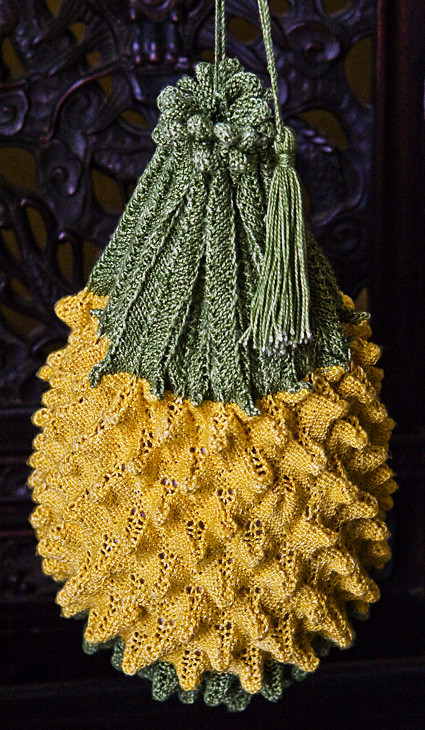

|
|
|
|
 by Franklin Habit, translated from “Pine
Apple Bag” in Jane Gaugain’s The
Lady’s
Assistant for Executing Useful and Fancy
Designs in Knitting, Netting and Crochet
Work (1840)
|
|
| Tweet | |
|
FINISHED MEASUREMENTS |
Approximately 12 inches high (excluding
ribbon trim) by 11 inches wide |
 |
|
MATERIALS Notions |
| GAUGE |
32 sts/48 round = 4 inches in stockinette stitch |
|
PATTERN NOTES |
The bag is knit in one piece, in the round,
from the top opening to the bottom. When changing from green
(leaves) to yellow (fruit), the work is turned inside-out. Historic colors. The original pattern calls for four shades of green, from light to dark; and four shades of yellow, from pale to "a rich brown." If you wish to imitate the historic colors, do so as follows: For the leaves, CO and work the first 7 rnds with lightest green. Thereafter, change to a successively darker shade of green every 7 rnds. For the fruit, begin with the lightest yellow, and change to a successively darker shade every 36 rnds. When all four shades of yellow have been used, switch back to green. Work four more repeats of Rnds 2–18, using each shade of green from darkest to lightest in successive repeats. Continue to use the lightest shade of green for the remainder of the bag. Beading option. The original pattern offers the option of adding beads ("gilt"–gold-plated or gold-colored metal) to the cast-on row and to the tip of the knobs in the yellow section of the fruit. Beaded stitches are noted in the pattern.
|
|
DIRECTIONS |
| LEAVES With MC, CO 320 sts. If you are beading, place a bead on every CO st. Join to work in the round, being careful not to twist. Place marker to indicate start of round. K 1 rnd. Begin leaf pattern: Repeat Rnd 2 26 more times. Break yarn, leaving 6–8 inch tail. FRUIT Note that your rounds will now reverse direction, and this
will leave a small hole at point where
Rnd 2 begins. Don’t
fret -- you can neaten it up during finishing. Repeat Rnds 1–18 6 more times, and Rnds 1–17 once more. Cut yarn, leaving 6-8 inch tail. Join MC. If you were beading, stop at this point. Bottom Cut yarn, leaving 6-8 inch tail. Run tail through remaining sts and pull to close bottom of bag. FINISHING Mrs. Gaugain requires that the bottom of the bag be trimmed with “a bunch of green satin ribbon, rounded at the points like leaves.” I rounded both ends of eight short lengths of ribbon, then sewed them with silk thread to the point at which the bag stitches were drawn together. She also specifies that the finished bag is “drawn in at the termination of the top leaves.” That’s all she says, however–leaving it up to the knitter to decide what to use for a drawstring. I decided to use a braid, as follows: Instead of braid you could use a length of silk cord or ribbon. If you’re concerned with period accuracy, do not use I-cord. There are no indications in the original pattern that the bag is to be lined; but if you plan to carry very small or weighty items in your pineapple, and simple silk or cotton lining sewn into the fruit is a very good idea. |
|
|
| ABOUT THE DESIGNER |
| Franklin Habit is one of those insanely
lucky people who plays with stuff like
this for a living. He wrote a book, It
Itches: A Stash of Knitting Cartoons (Interweave
Press) that recently came out in paperback.
His popular blog, The
Panopticon, veers wildly between
mid-Victorian sobriety and outright hallucination. He will be using the completed pineapple bag to carry his sneakers to the gymnasium. Fashion is all about surprise. |
| Pattern & images © 2012. Franklin Habit. |